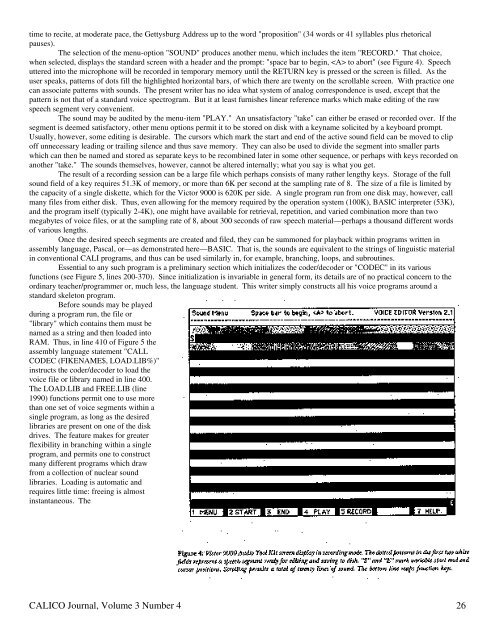MASTER (') S VOICE: THE VICTOR 9000 AND HIGH-FIDELITY ...
MASTER (') S VOICE: THE VICTOR 9000 AND HIGH-FIDELITY ...
MASTER (') S VOICE: THE VICTOR 9000 AND HIGH-FIDELITY ...
You also want an ePaper? Increase the reach of your titles
YUMPU automatically turns print PDFs into web optimized ePapers that Google loves.
time to recite, at moderate pace, the Gettysburg Address up to the word "proposition" (34 words or 41 syllables plus rhetorical<br />
pauses).<br />
The selection of the menu-option "SOUND" produces another menu, which includes the item "RECORD." That choice,<br />
when selected, displays the standard screen with a header and the prompt: "space bar to begin, to abort" (see Figure 4). Speech<br />
uttered into the microphone will be recorded in temporary memory until the RETURN key is pressed or the screen is filled. As the<br />
user speaks, patterns of dots fill the highlighted horizontal bars, of which there are twenty on the scrollable screen. With practice one<br />
can associate patterns with sounds. The present writer has no idea what system of analog correspondence is used, except that the<br />
pattern is not that of a standard voice spectrogram. But it at least furnishes linear reference marks which make editing of the raw<br />
speech segment very convenient.<br />
The sound may be audited by the menu-item "PLAY." An unsatisfactory "take" can either be erased or recorded over. If the<br />
segment is deemed satisfactory, other menu options permit it to be stored on disk with a keyname solicited by a keyboard prompt.<br />
Usually, however, some editing is desirable. The cursors which mark the start and end of the active sound field can be moved to clip<br />
off unnecessary leading or trailing silence and thus save memory. They can also be used to divide the segment into smaller parts<br />
which can then be named and stored as separate keys to be recombined later in some other sequence, or perhaps with keys recorded on<br />
another "take." The sounds themselves, however, cannot be altered internally; what you say is what you get.<br />
The result of a recording session can be a large file which perhaps consists of many rather lengthy keys. Storage of the full<br />
sound field of a key requires 51.3K of memory, or more than 6K per second at the sampling rate of 8. The size of a file is limited by<br />
the capacity of a single diskette, which for the Victor <strong>9000</strong> is 620K per side. A single program run from one disk may, however, call<br />
many files from either disk. Thus, even allowing for the memory required by the operation system (100K), BASIC interpreter (53K),<br />
and the program itself (typically 2-4K), one might have available for retrieval, repetition, and varied combination more than two<br />
megabytes of voice files, or at the sampling rate of 8, about 300 seconds of raw speech material—perhaps a thousand different words<br />
of various lengths.<br />
Once the desired speech segments are created and filed, they can be summoned for playback within programs written in<br />
assembly language, Pascal, or—as demonstrated here—BASIC. That is, the sounds are equivalent to the strings of linguistic material<br />
in conventional CALI programs, and thus can be used similarly in, for example, branching, loops, and subroutines.<br />
Essential to any such program is a preliminary section which initializes the coder/decoder or "CODEC" in its various<br />
functions (see Figure 5, lines 200-370). Since initialization is invariable in general form, its details are of no practical concern to the<br />
ordinary teacher/programmer or, much less, the language student. This writer simply constructs all his voice programs around a<br />
standard skeleton program.<br />
Before sounds may be played<br />
during a program run, the file or<br />
"library" which contains them must be<br />
named as a string and then loaded into<br />
RAM. Thus, in line 410 of Figure 5 the<br />
assembly language statement "CALL<br />
CODEC (FIKENAME$, LOAD.LIB%)"<br />
instructs the coder/decoder to load the<br />
voice file or library named in line 400.<br />
The LOAD.LIB and FREE.LIB (line<br />
1990) functions permit one to use more<br />
than one set of voice segments within a<br />
single program, as long as the desired<br />
libraries are present on one of the disk<br />
drives. The feature makes for greater<br />
flexibility in branching within a single<br />
program, and permits one to construct<br />
many different programs which draw<br />
from a collection of nuclear sound<br />
libraries. Loading is automatic and<br />
requires little time: freeing is almost<br />
instantaneous. The<br />
CALICO Journal, Volume 3 Number 4 26
















